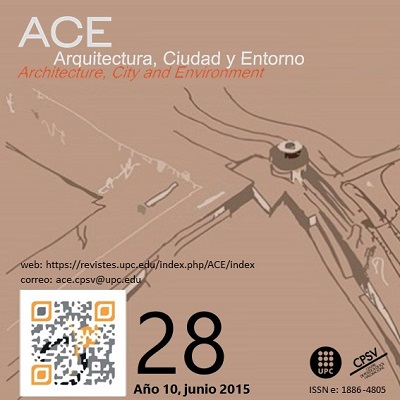Pioneros de la participación colectiva en los procesos de planificación urbana. Legado Halprin
DOI:
https://doi.org/10.5821/ace.10.28.3681Palabras clave:
Halprin, Participación, Planificación urbana, Democracia, Creación colectivaResumen
Este escrito plantea referenciar, traducir a la actualidad y destacar la trascendente labor que Anna y Lawrence Halprin desarrollaron al respecto de los procesos de creación colectiva aplicados tanto a la planificación urbana como al proyecto arquitectónico desde la década de los años cincuenta hasta la muerte de Lawrence en el año 2009.
Para definir el marco de actuación se repasa por un lado de forma somera el estado normativo y conceptual de la participación en España, y por otro las intensas biografías de Anna y Lawrence situadas en el corazón de acontecimientos decisivos que han influenciado definitoriamente en la evolución del arte y también de la sociedad occidental de las últimas décadas.
La investigación se centra en un exhaustivo trabajo de revisión bibliográfica de ambas figuras y en el análisis de gran parte del material publicado. Interpretando y descifrando la documentación consultada para una posible aplicación contemporánea a un contexto de reivindicación social en la cultura occidental con evidentes paralelismos a lo acaecido en los años sesenta americanos.
La pareja Halprin desempeña un papel trascendental en la evolución conceptual tanto del planeamiento urbano como de las artes escénicas y ejemplifica una concurrencia paradigmática de la arquitectura y la danza. Este cruce singular, muy poco documentado en la Europa continental y prácticamente nulo en lengua española, nos aporta el conocimiento de posibles alternativas ya comprobadas con acierto en la construcción participada de la ciudad.Descargas
Publicado
Número
Sección
Licencia
COPYRIGHT
El contenido de los artículos y los comentarios en ellos expresados son responsabilidad exclusiva de sus autores, y no reflejan necesariamente la opinión del comité editor de la revista. Los trabajos publicados por ACE pueden reproducirse bajo la licencia CC-BY-NC-ND 3.0 ES más información http://creativecommons.org/licenses/by-nc-nd/3.0/es/
Lo que implica que las personas autoras sólo retienen y mantienen los derechos de Copyright dentro de las limitaciones incluidas en la licencia anterior.





































